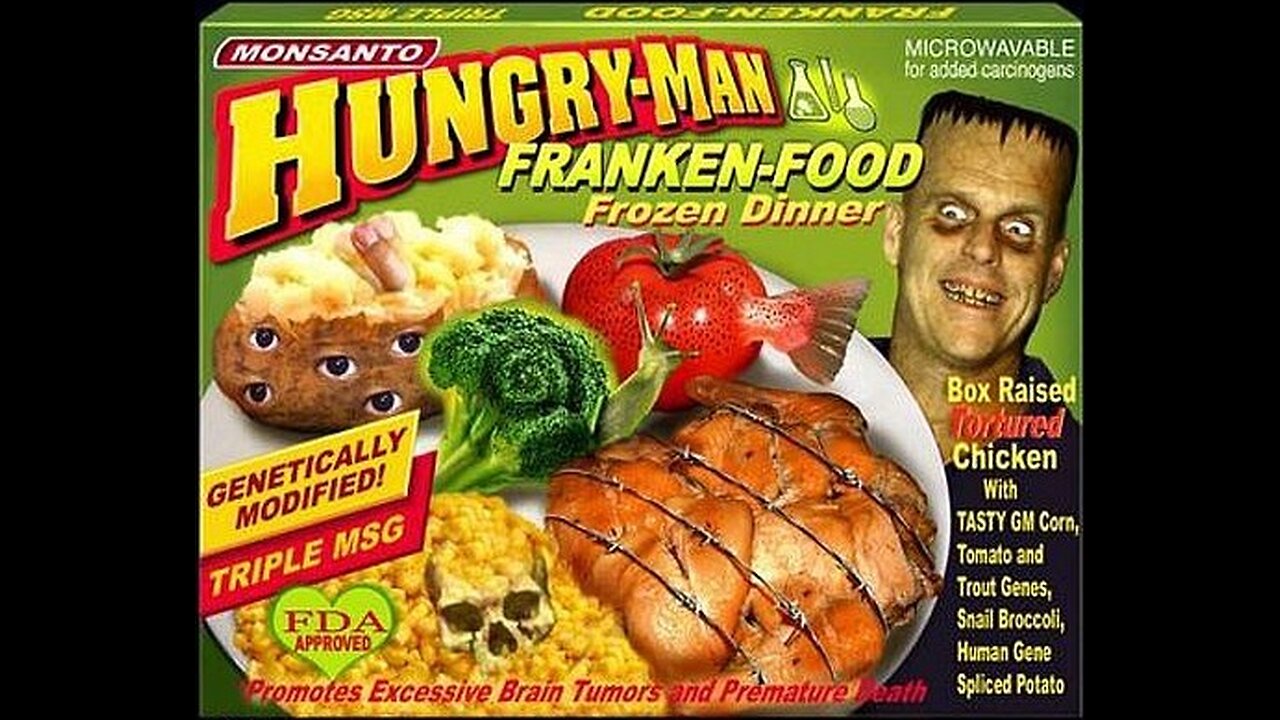Premium Only Content

600 Billion Dollars Poison Ingredient Making Your Food Toxic To Eat Processed Food
Nina deserves a lot more accreditation on this video, she was one of the first people to shed light on the problems with seed oils and the history of how they came to be. Top Ten Toxic Food Ingredients in Processed Food - Any food that has been canned, dehydrated, or had chemicals added to it is a processed food, and these foods make up about 60 percent of the average American diet. - Most of us don't think of the food we eat as poison, but some of the ingredients commonly found in processed foods can be considered toxic. By "toxic," I mean chemicals or highly processed ingredients that aren't good for you or can cause harm to your health. I'm talking about refined grains, trans fats, high fructose corn syrup, and all the other artificial junk you can't even pronounce on the ingredient lists.
0:00 - The Switcheroo
1:52 - History of Vegetable Oils
3:50 - Enter the American Heart Association
5:27 - The Massive Increase in Vegetable Oil Consumption
6:06 - Is Vegetable Oil Bad or Benign?
6:55 - Why do some animals live longer than others?
7:51 - Vegetable Oil is stays in your body for years
9:11 - Hidden Data
12:08 - Vegetable Oils are in EVERYTHING
13:07 - Why Vegetable Oils are bad for Health
15:04 - The Toxic Oxidation Products
16:28 - How Vegetable Oils are made
18:33 - Are Vegetable Oils linked to Alzheimer’s?
20:06 - Mitochondria, The Powerhouse of the Cell
24:35 - Most Studies on Vegetable Oils aren’t long enough
26:04 - Why aren’t more people talking about this?
Any food that has been canned, dehydrated, or had chemicals added to it is a processed food, and these foods make up about 60 percent of the average American diet. They've taken over, and we have to FIGHT BACK. Know which toxic food ingredients to avoid:
1. Palm Oil
When a regular fat like corn, soybean, or palm oil is blasted with hydrogen and turned into a solid, it becomes a trans fat. These evil anti-nutrients help packaged foods stay "fresh," meaning that the food can sit on the supermarket shelf for years without ever getting stale or rotting. Eating junk food with trans fats raises your "bad" LDL cholesterol and triglycerides and lowers your "good" HDL. These fats also increase your risk of blood clots and heart attack. Avoid palm oil and other trans fats like the plague, and kiss fried foods goodbye too, since they're usually fried in one of these freakish trans-fatty oils.
2. Shortening
Ditch any food that lists shortening or partially hydrogenated oil as an ingredient, since these are also evil trans fats. In addition to clogging your arteries and causing obesity, they also increase your risk of metabolic syndrome. Choose healthier monounsaturated fats, such as olive, peanut and canola oils and foods that contain unsaturated omega-3 fatty acids instead.
3. White Flour, Rice, Pasta, and Bread
When a whole grain is refined, most of its nutrients are sucked out in an effort to extend its shelf life. Both the bran and germ are removed, and therefore all the fiber, vitamins, and minerals. Because these stripped down, refined grains are devoid of fiber and other nutrients, they're also easy to digest — TOO EASY. They send your blood sugar and insulin skyrocketing, which can lead to all sorts of problems. Replace processed grains with whole grains, like brown or wild rice, whole-wheat breads and pastas, barley, and oatmeal.
4. High Fructose Corn Syrup
The evil king of all refined grains is high fructose corn syrup (HFCS). The amount of refined sugar we consume has declined over the past 40 years, but we're consuming almost 20 times as much HFCS. According to researchers at Tufts University, Americans consume more calories from HFCS than any other source. It's in practically EVERYTHING. It increases triglycerides, boosts fat-storing hormones, and drives people to overeat and gain weight. Adopt my zero-tolerance policy, and steer clear of this sweet "poison."
5. Artificial Sweeteners
Aspartame (NutraSweet, Equal), saccharin (Sweet'N Low, SugarTwin), and sucralose (Splenda) may be even harder on our metabolic systems than plain old sugar. These supposedly diet-friendly sweeteners may actually be doing more harm than good! Studies suggest that artificial sweeteners trick the brain into forgetting that sweetness means extra calories, making people more likely to keep eating sweet treats without abandon. Nip it in the bud. Scan ingredient labels and ban all artificial sweeteners from entering your mouth.
6. Sodium Benzoate and Potassium Benzoate
These preservatives are sometimes added to soda to prevent mold from growing, but benzene is a known carcinogen that is also linked with serious thyroid damage. Dangerous levels of benzene can build up when plastic bottles of soda are exposed to heat or when the preservatives are combined with ascorbic acid (vitamin C). Don't risk it, people
7. Butylated Hydroxyanisole (BHA)
BHA is another potentially cancer-causing preservative, but it has been deemed safe by the FDA. Its job is to help prevent spoilage and food poisoning, but it's a major endocrine disruptor and can seriously mess with your hormones. BHA is in HUNDREDS of foods. It's also found in food packaging and cosmetics. BHA has many aliases. You can look them up. Or you can follow my advice and DITCH processed foods altogether.
8. Sodium Nitrates and Sodium Nitrites
No that's not a typo. These two different preservatives are found in processed meats like bacon, lunch meat, and hot dogs. They're some of the worst offenders, and they're believed to cause colon cancer and metabolic syndrome, which can lead to diabetes. Protect your health by always choosing fresh, organic meats.
9. Blue, Green, Red, and Yellow
The artificial colors blue 1 and 2, green 3, red 3, and yellow 6 have been linked to thyroid, adrenal, bladder, kidney, and brain cancers. Always seek out foods with the fewest artificial chemicals, especially when shopping for your kids. Look for color-free medications and natural food products that don't contain artificial colors like these.
10. MSG
Monosodium glutamate is a processed "flavor enhancer." While glutamates are present in some natural foods, such as meat and cheese, the ones exploited by the processed-foods industry are separated from their host proteins through hydrolysis. The jury is still out on how harmful MSG may be, but high levels of free glutamates have been shown to seriously screw with brain chemistry. Don't fall prey to chemical flavor enhancing. Just play it safe and flavor your food naturally.
Whole Foods Market is often seen as the benchmark for products to be considered. The following list contains ingredients that Whole Foods Market finds unacceptable in food products, as posted on their website.
Using a preservative to keep your fair trade chocolate shelf-stable? Are you sure the colors in your organic hard candies are up to WFM standards? Go ahead any questionable names in your ingredient deck—if they pop up on the list, reformulation may be in the cards for your natural product.
Note: This list is reprinted in full from Whole Foods Market’s website. It’s a living list, so be sure to check back for future updates.
https://peoplesfood.coop/newsite/wp-content/uploads/2019/02/Unacceptable-Ingredients-2.pdf
50 Jaw-droppingly Toxic Food Ingredients & Artificial Additives to Avoid ? Yes ?
There have been great advances in food preparation in the last century. These days, well over half of the foods that we can buy in a typical supermarket are pre packaged or prepared. They need either no or minimal preparation before being ready to eat. However, there is a dark side to this convenience. Most of the foods on our shelves also contain chemicals and additives that are known to harm either the human body or laboratory animals. If they harm animals, they can harm you too. Most of the ingredients that you should avoid fall into one of three areas: food additives, artificial sweeteners and artificial colors. More and more experts are agreeing that you are wise to try to avoid as many chemicals in your foods as possible. By shopping in mostly the produce, dairy and meat sections of your grocery store, you can avoid many of the harmful food additives listed below. However, all of us need to be on our guard, because some of these ingredients also are used in meats, dairy products and even produce. What does this have to do with Public health? The health of our country is determined by the things we consume. This ultimately adds massive costs to our healthcare system as more and more people experience disease from eating processed foods and additives.
Food Additives to Avoid
While FDA generally recognizes most additives on this list as ‘safe,’ there are growing concerns about the safety of many common food additives, if consumed in large quantities.
01. Sodium nitrate: Added to processed meats to stop bacterial growth. Linked to cancer in humans. (Worst Offender)
02. Sulfites: Used to keep prepared foods fresh. Can cause breathing difficulties in those sensitive to the ingredient.
03. Azodicarbonamide: Used in bagels and buns. Can cause asthma.
04. Potassium bromate: Added to breads to increase volume. Linked to cancer in humans.
05. Propyl gallate: Added to fat-containing products. Linked to cancer in humans
06. BHA/BHT: A fat preservative, used in foods to extend shelf life. Linked to cancerous tumor growth.
07. Propylene glycol: Better known as antifreeze. Thickens dairy products and salad dressing. Deemed ‘generally’ safe by FDA.
08. Butane: Put in chicken nuggets to keep them tasting fresh. A known carcinogen.
09. Monosodium glutamate (MSG): Flavor enhancer that can cause headaches. Linked in animal studies to nerve damage, heart problems and seizures.
10. Disodium inosinate: In snack foods. Contains MSG.
11. Disodium guanylate: Also used in snack foods, and contains MSG.
12. Enriched flour: Used in many snack foods. A refined starch that is made from toxic ingredients.
13. Recombinant Bovine Growth Hormone (rBGH): Geneticially-engineered version of natural growth hormone in cows. Boosts milk production in cows. Contains high levels of IGF-1, which is thought cause various types of cancer.
14. Refined vegetable oil: Includes soybean oil, corn oil, safflower oil, canola oil, and peanut oil. High in omega-6 fats, which are thought to cause heart disease and cancer.
15. Sodium benzoate: Used as a preservative in salad dressing and carbonated beverages. A known carcinogen and may cause damage our DNA.
16. Brominated vegetable oil: Keeps flavor oils in soft drinks suspended. Bromate is a poison and can cause organ damage and birth defects. Not required to be listed on food labels.
17. Propyl gallate: Found in meats, popcorn, soup mixes and frozen dinners. Shown to cause cancer in rats. Banned in some countries. Deemed safe by FDA.
18. Olestra: Fat-like substance that is unabsorbed by the body. Used in place of natural fats in some snack foods. Can cause digestive problems, and also not healthy for the heart.
19. Carrageenan: Stabilizer and thickening agent used in many prepared foods. Can cause ulcers and cancer.
20. Polysorbate 60: A thickener that is used in baked goods. Can cause cancer in laboratory animals.
21. Camauba wax: Used in chewing gums and to glaze certain foods. Can cause cancer and tumors.
22. Magnesium sulphate: Used in tofu, and can cause cancer in laboratory animals.
23. Chlorine dioxide: Used in bleaching flour. Can cause tumors and hyperactivity in children.
24. Paraben: Used to stop mold and yeast forming in foods. Can disrupt hormones in the body, and could be linked to breast cancer.
25. Sodium carboxymethyl cellulose: Used as a thickener in salad dressings. Could cause cancer in high quantities.
26. Aluminum: A preservative in some packaged foods that can cause cancer.
Artificial Sweeteners to Avoid
Artificial sweeteners are regulated by FDA, just as food additives are, but this does not apply to products ‘generally recognized as safe.
27. Saccharin: Carcinogen found to cause bladder cancer in rats. (Worst Offender)
28. Aspartame: An excitotoxin and thought to be a carcinogen. Can cause dizziness, headaches, blurred vision and stomach problems.
29. High fructose corn syrup: Sweetener made from corn starch. Made from genetically-modified corn. Causes obesity, diabetes, heart problems, arthritis and insulin resistance.
30. Acesulfame potassium: Used with other artificial sweeteners in diet sodas and ice cream. Linked to lung and breast tumors in rats.
31. Sucralose: Splenda. Can cause swelling of liver and kidneys and a shrinkage of the thymus gland.
32. Agave nectar: Sweetener derived from a cactus. Contains high levels of fructose, which causes insulin resistance, liver disease and inflammation of body tissues.
33. Bleached starch: Can be used in many dairy products. Thought to be related to asthma and skin irritations.
34. Tert butylhydroquinone: Used to preserve fish products. Could cause stomach tumors at high doses.
Artificial Food Colorings to Avoid
Food colorings are used to give foods a more attractive appearance, but some experts believe they cause serious health problems, including asthma and hyperactivity in children.
35. Red #40: Found in many foods to alter color. All modern food dyes are derived from petroleum. A carcinogen that is linked to cancer in some studies. Also can cause hyperactivity in children. Banned in some European countries. (Worst Offender)
36. Blue #1: Used in bakery products, candy and soft drinks. Can damage chromosomes and lead to cancer.
37. Blue #2: Used in candy and pet food beverages. Can cause brain tumors
38. Citrus red #1: Sprayed on oranges to make them look ripe. Can damage chromosomes and lead to cancer.
39. Citrus red #2: Used to color oranges. Can cause cancer if you eat the peel.
40. Green #3: Used in candy and beverages. May cause bladder tumors.
41. Yellow #5: Used in desserts, candy and baked goods. Thought to cause kidney tumors, according to some studies.
42. Yellow #6: A carcinogen used in sausage, beverages and baked goods. Thought to cause kidney tumors, according to some studies.
43. Red #2: A food coloring that may cause both asthma and cancer.
44. Red #3: A carcinogen. that is added to cherry pie filling, ice cream and baked goods. May cause nerve damage and thyroid cancer.
45. Caramel coloring: In soft drinks, sauces, pastries and breads. When made with ammonia, it can cause cancer in mice. Food companies not required to disclose if this ingredient is made with ammonia.
46. Brown HT: Used in many packaged foods. Can cause hyperactivity in children, asthma and cancer.
47. Orange B: A food dye that is used in hot dog and sausage casings. High doses are bad for the liver and bile duct.
48. Bixin: Food coloring that can cause hyperactivity in children and asthma.
49. Norbixin: Food coloring that can cause hyperactivity in children and asthma.
50. Annatto: Food coloring that can cause hyperactivity in children and asthma.
Opponents of GMOs have been unceasing in their campaign to vilify genetically modified foods by describing them as “Frankenfoods,” thus implying they are not natural and are potentially harmful.
“The practice of introducing new DNA and chemicals to seeds or animals (Aqua Advantage has developed a GMO fish) is similar to how Mary Shelly’s Frankenstein created his monster–—through piecing together lots of different organisms,” wrote the Organic Authority on its website—a common allusion in the anti-GMO world. “We all know what happened when the monster turned on Frankenstein, and many critics of genetic engineering have likened the inevitable backlash of GMO technology to the destruction and murderous rampage of Frankenstein’s monster.”
Many anti-GMO articles that warn of the dangers GM crops are often accompanied by an image of atomato fruit or vegetable with syringes sticking out of them. Very often it is a fruit or vegetable for which there is no current GM equivalent such as a tomato. This depiction is used to reinforce the notion that GM foods are created in laboratories and not by nature and therefore are dangerous to consume.
With the constant barrage of scare-based imagery, it is not surprising that there is widespread public suspicion that GMOs are dangerous to human health. But there is little controversy surrounding GMOs within the scientific community with 88 percent of the members of the American Association for the Advancement of Science believing GMOs are “generally safe.” The safety of GMOs were once again reinforced by the May 2016 report by the U.S. National Academy of Sciences, Engineering and Medicine, which concluded, there was “reasonable evidence that animals were not harmed by eating food derived from genetically engineered crops”, and epidemiological data indicated there was no increase in cancer or other health related problems associated with these crops entering our food supply.
David Zilberman, a professor of agriculture and resource economics at the University of California, Berkley, has noted that Frankenfood was “a terrible word, a stigmatization word, one that’s used to scare people… People are afraid of GMOs for little or no reason. GM is simply a tool. Because it allows us to modify plants with far greater precision and control then before, it will be very valuable.”
The reality is that the vast bulk of the foods we consume whether organic or conventionally grown have had their genetics altered in the field or in a laboratory via a process of selective breeding or advanced biotechnology techniques, and all such foods are safe to eat. The altering of genes in plants is even known to occur naturally as highlighted by the sweet potato.
Scientists at the International Potato Center in Lima, Peru have found genes from bacteria in 291 sweet potatoes varieties, some 8,000 years old, including ones grown in the U.S., Indonesia, China and parts of South America and Africa, “People have been eating a GMO for thousands of years without knowing it,” said virologist Jan Kreuze, who led the study… This example might be helpful for regulators and scientists looking at the safety of GM crops.
Modern foods are lab foods.
In one form or another many plant breeding techniques including GMOs rely upon the use of a laboratory; by that measure, most crops that are produced could be considered to be Frankenfoods. Here are some examples of non-GMO lab-created foods:
“Wide cross” hybridization involves crossing two individual plants belonging to different species and has created plants that do not exist naturally including varieties of corn, oats, pumpkins, wheat, tomatoes and potatoes.
The seedless watermelon is a polyploid which is a cell or organism that contains more than two
PM paired sets of chromosomes. It has three sets of chromosomes. Polyloidy can be induced in plants and cell cultures by using chemicals such as colchicine (a toxic natural occurring chemical that was originally extracted from a plant) and Oryzalin (which is used as an herbicide).
Seedless grapes are very unnatural clones, which are grown from cuttings—a form of asexual reproduction in which roots are treated with hormones to stimulate growth.
Hybrid crops have been developed using marker assisted selection, which is a laboratory process involving selecting certain traits in a plant such as drought or disease resistance based upon a genetic marker. Cross breeding may involve somatic fusion which is the fusion of two distinct plant species to form a new hybrid with the characteristic of both—for example Triticale, which is a fusion between wheat triticum and rye secale, and is often sold as an organic seed.
While the opponents of GMOs demonize them as Frankenfoods, they do not do the same for crops grown via a process of mutagenesis. The Ruby Red grapefruit, again often sold as organically grown, is an example of a variety of grapefruit created through mutagenesis, which is a form of genetic engineering that involves exposing seeds to chemicals or radiation, including X-rays, gamma rays and thermal neutrons, to generate mutants that have desirable traits. The Rio Red variety was developed using thermal neutrons. About three quarters of the grapefruits grown in Texas are Ruby Red varieties and in 1993, the Ruby Red was declared the state fruit of Texas. More than 3,000 plants have been produced utilizing mutagenesis including conventional and organic varieties of rice, pears, wheat, soybeans and sunflowers.
Although crops grown via GM technology and mutagenesis have both proved to be safe for human consumption and the environment, the National Academies has indicated that “regulating genetically modified crops while giving a pass to products of mutation breeding isn’t scientifically justified.” It should also be noted that genetic modification is a much more process and quicker method of breeding for certain traits then is mutagenesis. A report by the UK government’s GM Science Review Panel concluded, “mutation breeding involves the production of unpredictable plants and undirected genetic changes and many thousands, even millions, of undesirable plants are discarded in order to identify plants with suitable qualities for further breeding.”
Are GMOs inherently risky?
Henry I. Miller, a physician and molecular biologist, has addressed the notion of the supposed increased risks of genetically modified foods.
Wide-cross hybridizations and radiation-induced mutagenesis represent far more drastic tinkering with nature — and lead to far less predictable results—than the modern molecular techniques used to alter genes, but neither legislators nor anti-genetic-engineering activists have shown any concern about creating new plant varieties with those older techniques. Even though the outcomes would by any reasonable definition be genetically modified or bioengineered, they are not subject to mandatory testing or review before entering the food chain…In contrast, if a gene is moved by recombinant DNA techniques, the resulting variety is subject to lengthy, hugely expensive, and increasingly politicized regulation…To be clear, it’s not the source of genetic material or whether DNAs from different organisms are mixed that confers risk; what is important is the function of the genetic alteration—for example, whether it could cause the organism to express a new toxin or allergen or become more weed-like.
True Frankenfoods are not grown in laboratories as the opponents of GMOs would like people to believe but instead are natural foods which contain toxic substances. For example, rhubarb leaves are poisonous; if ingested, they could cause breathing problems, seizures, kidney failure and in some cases death. Castor oil is made from castor beans which contain ricin. The Ackee fruit of Jamaica has toxic black seeds. There are many poisonous types of mushrooms; consuming about half of a death cap mushroom for instance is deadly for adults.
Cassava contains linamarin; when eaten raw, the digestive system will convert it to cyanide. Eating just a few pieces of uncooked cassava root can provide a lethal dose. Potatoes contain solanine, a natural toxin. As a result, consuming an uncooked potato can cause vomiting and diarrhea. The National Institute of Health advises against eating potatoes that are green below the skin because it is an indication of a high concentration of solanine.
Acrylamide, found in potatoes, grain products and coffee, is classified by the EPA as “likely to be carcinogenic to humans” based on studies in lab animals. (Ironically, a potato that sharply reduces the production of acryladmide in fried potatoes has been developed by tweaking one gene—which has led anti-GMO activists to brand it a ‘dangerous Frankenfood’.)
The opponents of GMOs would like us to believe that genetic modification of crops has dangerous implications for our food supply. But the reality is that there is no evidence that it is inherently any more dangerous or riskier than any other plant breeding technique. It is merely another application of science to agriculture that is designed to help feed a growing word population.
Imagine if those who opposed grafting or hybridization because they viewed them as tampering with mother-nature and potentially dangerous to humans had succeeded in halting their development? If such were the case, the implications for humanity would have been quite detrimental. Those who oppose GM technology are likely to look just as foolish to future generations.
How does toxic eating effect our spiritual development?
As Einstein had said. “Everything is energy and that is all there is to it.” The Great Pythagoras said All is number. This franken food everything and All includes we human beings who are alchemical energies composed of a God given mathematical formula.
The key in the Great Work is perfecting ourselves through right thoughts and actions. When we abuse ourselves with bad thoughts, actions and bad living, we are unable to properly work on our soul’s development because we have changed the God given math code that makes us human. This change can lead us to become almost inhuman like beasts, devils and human parasites who are selfish creatures.
Much of our modern world is composed of many of these selfish human beasts and devils. This is the current state of most of humanity who has been on a course of devolution for hundreds of years.
Our goal as Modern Gnostics and Truth Seekers is to take the opposite path of the rest of humanity to the illuminating high road of evolution by practicing self control, pure living and to live by example.
If we eat toxic foods with unnatural ingredients and toxins, we take in toxic energies into our bodies as a result. This consumption toxins changes our “natural” alchemical energies we are born with. By doing this, we are not living pure and natural.
Our Great Work at purifying our souls then becomes clouded by these toxins that then create toxic bodies because our energies are turned into harmful gasses. When this happens, it turns our very chemical energies based on a God given mathematical formula at birth into gasses that are created by our own thoughts, and actions such as food, drink and air consumption. These unnatural gasses then envelop our blood, organs, and and minds that impede our spiritual development and can lead to an early death.
These gasses then provide the perfect hellish type environments for various types of parasites (devils and demons) who began to consume these gasses and our very bodies. Our blood, bones and organs become the breeding and eating grounds of millions of mutant parasites that even change our very DNA. Their vomit, feces and dead carcasses then make us sick and we die early of disease, cancer or putrefaction. Worms kinds in humans
I explain these concepts more in my articles on What is Hell where I show that bad food will make you have terrible smelly farts, bad breath, and also eventually make you fat and ugly. The same thing happens with your thoughts. They can give you health problems, wrinkles and make you both ugly on the inside and outside. This is because your thoughts and actions create a chemical energy reaction in your body and this is simply proven by how you feel after thinking about something.
We all need to learn that it is in our minds and thoughts that produce a fire or Force in our blood, that is a type of chemical Hell 3energy that needs to be tamed and controlled or it will simply control you. It is the Beast and serpent within that can become either like Jesus, Lucifer, or Satan, depending on how you think, act and react to this Force within.
When a person lives contrary to natural law of the evolved spiritual human and is ruled by his or her animal appetites and desires, which then lead to abuse of the mind, body and soul, causing sulfur to turn into hydrogen sulfide that then duplicates itself like a virus in the human body.
This is what Christians would call sinning, and living in hell as said by St. John in Revelation 21:8 – But the cowardly, the unbelieving, the vile, the murderers, the sexually immoral, those who practice magic arts, the idolaters and all liars–they will be consigned to the fiery lake of burning sulfur. This is the second death.”
A life lived in hell leads to an early death which simply means that the student cannot properly complete the Great Work.
The goal is to finish this work in the most healthy, happy and loving manner that you can given your current life. Therefor it is imperative that we not only seek to have healthy lives filled with as much happiness and love as possibly, but that we also eat and consume only the most natural, organic healthy foods and drinks.
Bioengineered (GMO) Foods ingredients - https://www.ams.usda.gov/sites/default/files/media/BE_Consumer.pdf
GMO Genetically Modified Organisms Transgenic Crops and Recombinant DNA Technology - https://rumble.com/v2dn1zu-gmo-genetically-modified-organisms-transgenic-crops-and-recombinant-dna-tec.html - Genetically Modified Organisms ? - So Poor Johnny doesn't like "healthy" food. What could possibly persuade him to eat all his "veggies"? If you could save lives by producing vaccines in transgenic bananas, would you? In the debate over large-scale commercialization and use of GMOs, where should we draw the line? you may use this film Only if it stays intact. No part of it. may be removed or used in part without our permission.
People have been altering the genomes of plants and animals for many years using traditional breeding techniques. Artificial selection for specific, desired traits has resulted in a variety of different organisms, ranging from sweet corn to hairless cats. But this artificial selection, in which organisms that exhibit specific traits are chosen to breed subsequent generations, has been limited to naturally occurring variations. In recent decades, however, advances in the field of genetic engineering have allowed for precise control over the genetic changes introduced into an organism. Today, we can incorporate new genes from one species into a completely unrelated species through genetic engineering, optimizing agricultural performance or facilitating the production of valuable pharmaceutical substances. Crop plants, farm animals, and soil bacteria are some of the more prominent examples of organisms that have been subject to genetic engineering.
Current Use of Genetically Modified Organisms Agricultural plants are one of the most frequently cited examples of genetically modified organisms (GMOs). Some benefits of genetic engineering in agriculture are increased crop yields, reduced costs for food or drug production, reduced need for pesticides, enhanced nutrient composition and food quality, resistance to pests and disease, greater food security, and medical benefits to the world's growing population.
An Introduction To Plant Breeding-Teaching Us about Preparing for a Plant Pandemic? - https://rumble.com/v2hf5zq-an-introduction-to-plant-breeding-teaching-us-about-preparing-for-a-plant-p.html - Plant breeding is a technique through which genetic traits of a plant are changed. Some desirable traits are incorporated to produce a new variety. This technique is mainly used to improve the quality of food crop, to produce high yielding crop varieties and also provide resistance to diseases and pests. Teach Us about Preparing for a Plant Pandemic ? The question is not whether we’ll experience such an event; it’s whether we’ll be ready when it strikes As the world continues to fight COVID-19, the menace of infectious disease has never been more apparent. The next devastating pandemic could strike plants. Agricultural pathogens are evolving and spreading at a troubling rate—and the COVID pandemic offers important lessons for how we should prepare for them.
You Will Get Your Plant Derived Vaccines Explained in 12 Minutes Or Death 2 You ? - https://rumble.com/v2heu0u-you-will-get-your-plant-derived-vaccines-explained-in-12-minutes-or-death-2.html - PMI Announces Medicago to Supply Up to 76 Million Doses of Its Plant-Derived COVID-19 Vaccine Candidate A Philip Morris International subsidiary is a shareholder in a biopharmaceutical company that reached agreements with two departments of the Canadian government to accelerate its COVID-19 vaccine candidate efforts. Since 2008, Philip Morris Investments B.V. (PMIBV), a subsidiary of Philip Morris International (PMI) (NYSE: PM), has been a shareholder of Medicago (in which it currently holds an approximately one-third equity stake) and has supported Medicago’s innovative plant-derived research and development focused on vaccines. The investment is consistent with PMI’s own efforts to leverage science and innovation. Japan-based Mitsubishi Tanabe Pharma Corporation (MTPC) is the majority shareholder and PMIBV’s partner in Medicago. Among other things, PMIBV and MTPC will contribute additional funding to support Medicago’s efforts to develop a COVID-19 vaccine candidate.
What’s in a Covid-19 Vaccine? - Everyone Will Now Get Edible Vaccine in Your Food - https://rumble.com/v2hecds-whats-in-a-covid-19-vaccine-everyone-will-now-get-edible-vaccine-in-your-fo.html - Plant biologist injecting tiny amounts of virus into tomato, potato, lettuce leaves. University of Ottawa plant biologist Allyson MacLean demonstrates the process for injecting edible plants with bacterial solution, which will hopefully cause the leaves to gradually produce a vaccine for COVID-19. Eating your veggies isn't only good for you — it may someday protect you against COVID-19.
In-Depth Plant-Based Covid-19 Vaccine People Testing's Now-You Will Eat Your Shot - https://rumble.com/v2hftq4-in-depth-plant-based-covid-19-vaccine-people-testings-now-you-will-eat-your.html - Anti-GMO forces target New Breeding Techniques (NBTs) despite similarities to conventional crops For years, critics of GMOs have focused on the idea that modern technologies have allowed plant breeders to take genetic material from one species and add it to another—adding ‘foreign genes’, they call it.
These transgenic crosses are responsible for most of the GMO crops that dominate US farmland. But they’ve also offered a rallying point for critics, who’ve built a deceptive narrative around the idea that these “Frankenfoods” should be feared and shunned by consumers.
Genetically Modified Organisms (GMOs): Transgenic Crops and Recombinant DNA Technology - If you could save lives by producing vaccines in transgenic bananas, would you? In the debate over large-scale commercialization and use of GMOs, where should we draw the line?
People have been altering the genomes of plants and animals for many years using traditional breeding techniques. Artificial selection for specific, desired traits has resulted in a variety of different organisms, ranging from sweet corn to hairless cats. But this artificial selection, in which organisms that exhibit specific traits are chosen to breed subsequent generations, has been limited to naturally occurring variations. In recent decades, however, advances in the field of genetic engineering have allowed for precise control over the genetic changes introduced into an organism. Today, we can incorporate new genes from one species into a completely unrelated species through genetic engineering, optimizing agricultural performance or facilitating the production of valuable pharmaceutical substances. Crop plants, farm animals, and soil bacteria are some of the more prominent examples of organisms that have been subject to genetic engineering.
Current Use of Genetically Modified Organisms
A photograph shows five silver fish oriented horizontally in a vertical row against a black background. Below, five smaller fish are also arranged similarly. The smaller fish at bottom are approximately one-third the length of the fish at top.
Agricultural plants are one of the most frequently cited examples of genetically modified organisms (GMOs). Some benefits of genetic engineering in agriculture are increased crop yields, reduced costs for food or drug production, reduced need for pesticides, enhanced nutrient composition and food quality, resistance to pests and disease, greater food security, and medical benefits to the world's growing population. Advances have also been made in developing crops that mature faster and tolerate aluminum, boron, salt, drought, frost, and other environmental stressors, allowing plants to grow in conditions where they might not otherwise flourish (Table 1; Takeda & Matsuoka, 2008). Other applications include the production of nonprotein (bioplastic) or nonindustrial (ornamental plant) products. A number of animals have also been genetically engineered to increase yield and decrease susceptibility to disease. For example, salmon have been engineered to grow larger (Figure 1) and mature faster (Table 1), and cattle have been enhanced to exhibit resistance to mad cow disease (United States Department of Energy, 2007).
The pharmaceutical industry is another frontier for the use of GMOs. In 1986, human growth hormone was the first protein pharmaceutical made in plants (Barta et al., 1986), and in 1989, the first antibody was produced (Hiatt et al., 1989). Both research groups used tobacco, which has since dominated the industry as the most intensively studied and utilized plant species for the expression of foreign genes (Ma et al., 2003). As of 2003, several types of antibodies produced in plants had made it to clinical trials. The use of genetically modified animals has also been indispensible in medical research. Transgenic animals are routinely bred to carry human genes, or mutations in specific genes, thus allowing the study of the progression and genetic determinants of various diseases.
Potential GMO Applications
Many industries stand to benefit from additional GMO research. For instance, a number of microorganisms are being considered as future clean fuel producers and biodegraders. In addition, genetically modified plants may someday be used to produce recombinant vaccines. In fact, the concept of an oral vaccine expressed in plants (fruits and vegetables) for direct consumption by individuals is being examined as a possible solution to the spread of disease in underdeveloped countries, one that would greatly reduce the costs associated with conducting large-scale vaccination campaigns. Work is currently underway to develop plant-derived vaccine candidates in potatoes and lettuce for hepatitis B virus (HBV), enterotoxigenic Escherichia coli (ETEC), and Norwalk virus. Scientists are also looking into the production of other commercially valuable proteins in plants, such as spider silk protein and polymers that are used in surgery or tissue replacement (Ma et al., 2003). Genetically modified animals have even been used to grow transplant tissues and human transplant organs, a concept called xenotransplantation. The rich variety of uses for GMOs provides a number of valuable benefits to humans, but many people also worry about potential risks.
Risks and Controversies Surrounding the Use of GMOs
Despite the fact that the genes being transferred occur naturally in other species, there are unknown consequences to altering the natural state of an organism through foreign gene expression. After all, such alterations can change the organism's metabolism, growth rate, and/or response to external environmental factors. These consequences influence not only the GMO itself, but also the natural environment in which that organism is allowed to proliferate. Potential health risks to humans include the possibility of exposure to new allergens in genetically modified foods, as well as the transfer of antibiotic-resistant genes to gut flora.
Horizontal gene transfer of pesticide, herbicide, or antibiotic resistance to other organisms would not only put humans at risk, but it would also cause ecological imbalances, allowing previously innocuous plants to grow uncontrolled, thus promoting the spread of disease among both plants and animals. Although the possibility of horizontal gene transfer between GMOs and other organisms cannot be denied, in reality, this risk is considered to be quite low. Horizontal gene transfer occurs naturally at a very low rate and, in most cases, cannot be simulated in an optimized laboratory environment without active modification of the target genome to increase susceptibility (Ma et al., 2003).
In contrast, the alarming consequences of vertical gene transfer between GMOs and their wild-type counterparts have been highlighted by studying transgenic fish released into wild populations of the same species (Muir & Howard, 1999). The enhanced mating advantages of the genetically modified fish led to a reduction in the viability of their offspring. Thus, when a new transgene is introduced into a wild fish population, it propagates and may eventually threaten the viability of both the wild-type and the genetically modified organisms.
Unintended Impacts on Other Species: The Bt Corn Controversy
One example of public debate over the use of a genetically modified plant involves the case of Bt corn. Bt corn expresses a protein from the bacterium Bacillus thuringiensis. Prior to construction of the recombinant corn, the protein had long been known to be toxic to a number of pestiferous insects, including the monarch caterpillar, and it had been successfully used as an environmentally friendly insecticide for several years. The benefit of the expression of this protein by corn plants is a reduction in the amount of insecticide that farmers must apply to their crops. Unfortunately, seeds containing genes for recombinant proteins can cause unintentional spread of recombinant genes or exposure of non-target organisms to new toxic compounds in the environment.
The now-famous Bt corn controversy started with a laboratory study by Losey et al. (1999) in which the mortality of monarch larvae was reportedly higher when fed with milkweed (their natural food supply) covered in pollen from transgenic corn than when fed milkweed covered with pollen from regular corn. The report by Losey et al. was followed by another publication (Jesse & Obrycki, 2000) suggesting that natural levels of Bt corn pollen in the field were harmful to monarchs.
Debate ensued when scientists from other laboratories disputed the study, citing the extremely high concentration of pollen used in the laboratory study as unrealistic, and concluding that migratory patterns of monarchs do not place them in the vicinity of corn during the time it sheds pollen. For the next two years, six teams of researchers from government, academia, and industry investigated the issue and concluded that the risk of Bt corn to monarchs was "very low" (Sears et al., 2001), providing the basis for the U.S. Environmental Protection Agency to approve Bt corn for an additional seven years.
Unintended Economic Consequences
Another concern associated with GMOs is that private companies will claim ownership of the organisms they create and not share them at a reasonable cost with the public. If these claims are correct, it is argued that use of genetically modified crops will hurt the economy and environment, because monoculture practices by large-scale farm production centers (who can afford the costly seeds) will dominate over the diversity contributed by small farmers who can't afford the technology. However, a recent meta-analysis of 15 studies reveals that, on average, two-thirds of the benefits of first-generation genetically modified crops are shared downstream, whereas only one-third accrues upstream (Demont et al., 2007). These benefit shares are exhibited in both industrial and developing countries. Therefore, the argument that private companies will not share ownership of GMOs is not supported by evidence from first-generation genetically modified crops.
GMOs and the General Public: Philosophical and Religious Concerns
In a 2007 survey of 1,000 American adults conducted by the International Food Information Council (IFIC), 33% of respondents believed that biotech food products would benefit them or their families, but 23% of respondents did not know biotech foods had already reached the market. In addition, only 5% of those polled said they would take action by altering their purchasing habits as a result of concerns associated with using biotech products.
According to the Food and Agriculture Organization of the United Nations, public acceptance trends in Europe and Asia are mixed depending on the country and current mood at the time of the survey (Hoban, 2004). Attitudes toward cloning, biotechnology, and genetically modified products differ depending upon people's level of education and interpretations of what each of these terms mean. Support varies for different types of biotechnology; however, it is consistently lower when animals are mentioned.
Furthermore, even if the technologies are shared fairly, there are people who would still resist consumable GMOs, even with thorough testing for safety, because of personal or religious beliefs. The ethical issues surrounding GMOs include debate over our right to "play God," as well as the introduction of foreign material into foods that are abstained from for religious reasons. Some people believe that tampering with nature is intrinsically wrong, and others maintain that inserting plant genes in animals, or vice versa, is immoral. When it comes to genetically modified foods, those who feel strongly that the development of GMOs is against nature or religion have called for clear labeling rules so they can make informed selections when choosing which items to purchase. Respect for consumer choice and assumed risk is as important as having safeguards to prevent mixing of genetically modified products with non-genetically modified foods. In order to determine the requirements for such safeguards, there must be a definitive assessment of what constitutes a GMO and universal agreement on how products should be labeled.
These issues are increasingly important to consider as the number of GMOs continues to increase due to improved laboratory techniques and tools for sequencing whole genomes, better processes for cloning and transferring genes, and improved understanding of gene expression systems. Thus, legislative practices that regulate this research have to keep pace. Prior to permitting commercial use of GMOs, governments perform risk assessments to determine the possible consequences of their use, but difficulties in estimating the impact of commercial GMO use makes regulation of these organisms a challenge.
History of International Regulations for GMO Research and Development
In 1971, the first debate over the risks to humans of exposure to GMOs began when a common intestinal microorganism, E. coli, was infected with DNA from a tumor-inducing virus (Devos et al., 2007). Initially, safety issues were a concern to individuals working in laboratories with GMOs, as well as nearby residents. However, later debate arose over concerns that recombinant organisms might be used as weapons. The growing debate, initially restricted to scientists, eventually spread to the public, and in 1974, the National Institutes of Health (NIH) established the Recombinant DNA Advisory Committee to begin to address some of these issues.
In the 1980s, when deliberate releases of GMOs to the environment were beginning to occur, the U.S. had very few regulations in place. Adherence to the guidelines provided by the NIH was voluntary for industry. Also during the 1980s, the use of transgenic plants was becoming a valuable endeavor for production of new pharmaceuticals, and individual companies, institutions, and whole countries were beginning to view biotechnology as a lucrative means of making money (Devos et al., 2007). Worldwide commercialization of biotech products sparked new debate over the patentability of living organisms, the adverse effects of exposure to recombinant proteins, confidentiality issues, the morality and credibility of scientists, the role of government in regulating science, and other issues. In the U.S., the Congressional Office of Technology Assessment initiatives were developed, and they were eventually adopted worldwide as a top-down approach to advising policymakers by forecasting the societal impacts of GMOs.
Then, in 1986, a publication by the Organization for Economic Cooperation and Development (OECD), called "Recombinant DNA Safety Considerations," became the first intergovernmental document to address issues surrounding the use of GMOs. This document recommended that risk assessments be performed on a case-by-case basis. Since then, the case-by-case approach to risk assessment for genetically modified products has been widely accepted; however, the U.S. has generally taken a product-based approach to assessment, whereas the European approach is more process based (Devos et al., 2007). Although in the past, thorough regulation was lacking in many countries, governments worldwide are now meeting the demands of the public and implementing stricter testing and labeling requirements for genetically modified crops.
Increased Research and Improved Safety Go Hand in Hand
Proponents of the use of GMOs believe that, with adequate research, these organisms can be safely commercialized. There are many experimental variations for expression and control of engineered genes that can be applied to minimize potential risks. Some of these practices are already necessary as a result of new legislation, such as avoiding superfluous DNA transfer (vector sequences) and replacing selectable marker genes commonly used in the lab (antibiotic resistance) with innocuous plant-derived markers (Ma et al., 2003). Issues such as the risk of vaccine-expressing plants being mixed in with normal foodstuffs might be overcome by having built-in identification factors, such as pigmentation, that facilitate monitoring and separation of genetically modified products from non-GMOs. Other built-in control techniques include having inducible promoters (e.g., induced by stress, chemicals, etc.), geographic isolation, using male-sterile plants, and separate growing seasons.
GMOs benefit mankind when used for purposes such as increasing the availability and quality of food and medical care, and contributing to a cleaner environment. If used wisely, they could result in an improved economy without doing more harm than good, and they could also make the most of their potential to alleviate hunger and disease worldwide. However, the full potential of GMOs cannot be realized without due diligence and thorough attention to the risks associated with each new GMO on a case-by-case basis.
-
 1:25:52
1:25:52
What If Everything You Were Taught Was A Lie?
7 days agoAmerica Is Collapsing Today Bible Text Is Not What You Think No Church No Religion No Synagogue
1.68K2 -
 LIVE
LIVE
LFA TV
1 hour agoLFA TV ALL DAY STREAM - THURSDAY 9/4/25
11,710 watching -
 1:16:35
1:16:35
JULIE GREEN MINISTRIES
2 hours agoLIVE WITH JULIE
29.9K80 -
 LIVE
LIVE
Welcome to the Rebellion Podcast
12 hours agoDon3po is Live - WTTR Podcast Live 9/4
261 watching -
 13:43
13:43
The Kevin Trudeau Show Limitless
23 hours agoClassified File 3 | Kevin Trudeau EXPOSES Secret Society Brainwave Training
44.5K9 -
 LIVE
LIVE
The Chris Salcedo Show
12 hours agoAmericans Are Tired Of Leftists & Fake-GOP Who Cater To Them
602 watching -
 1:12:23
1:12:23
Game On!
19 hours ago $0.94 earnedFootball IS BACK! Cowboys vs Eagles Opening Night Kickoff!
7.32K1 -
 LIVE
LIVE
The Bubba Army
23 hours ago#1 Documentary IN THE WORLD! - Bubba the Love Sponge® Show | 9/04/25
2,282 watching -
 39:31
39:31
Her Patriot Voice
14 hours ago $1.84 earnedBlack Conservative Surrounded + ROBBED By Leftists!
11.2K23 -
 13:25
13:25
The Gun Collective
14 hours agoWOW! A LOT of new GUNS just dropped!
12.7K7